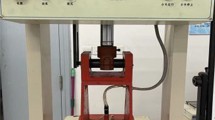Abstract
Wet skid resistance is one of the basic properties for tread rubber, which plays an important role in driving performance of vehicles. Firstly, a new test device has been developed for testing wet skid resistance of tread rubber. Then, effect of filled nano silicon, water film depth, normal load and sliding velocity on friction properties of tread rubber have been studied, and contact pressure under different pavement parameters of Rsm, Ra also has been investigated. Finally, friction surface morphology of tread rubber has been investigated by OLYMPUS-DSX510 Optical Digital Microscope. Results indicate that nano silicon instead of silica (white carbon black) can significantly improve wet skid resistance with the same mechanical properties, replacement ratio of 40% is the best; friction coefficient of tread rubber block decreases when the normal load increases, however, it increases and then decreases when sliding velocity increases under dry and wet conditions; contact pressure increases with the increase of Rsm, however, it decreases when Ra increases.












Similar content being viewed by others
References
Persson BNJ (2007) Wet adhesion with application to tree frog adhesive toe pads and tires. J Phys Condens Matter 19(37):1–16
Persson BNJ (2011) Rubber friction and tire dynamics. J Phys Condens Matter 23(1):1–14
Rajesh R, Gridsada P, Damrongrit P, Jae YL (2012) Algorithms for real-time estimation of individual wheel tire-road friction coefficients. IEEE/ASME Transactions on Mechatronics 17(6):1183–1195
Wang Y, Wu Y, Li W, Zhang L (2011) Influence of filler type on wet skid resistance of SSBR/BR composites: effects from roughness and micro-hardness of rubber surface. Appl Surf Sci 257:2058–2065
Alauddin A, Tighesusan L (2012) Asphalt pavements surface texture and skid resistance—exploring the reality. Can J Civ Eng 39(1):1–9
Torbruegge S, Wies B (2015) Characterization of pavement texture by means of height difference correlation and relationtowetskid resistance. Journal of Traffic & Transportation Engineering 2(2):59–67
Kogbara RB, Masad EA, Kassem E, Scarpas A, Anupam K (2016) A state-of-the-art review of parameters influencing measurement and modeling of skid resistance of asphalt pavements. Constr Build Mater 114:602–617
Minh-Tan D, Veronique C, Yannick B, Malal K (2014) Influence of thin water film on skid resistance. Journal of Traffic & Transportation Engineering 2:36–44
Hadiwardoyo SP, Sinaga ES, Fikri H (2013) The influence of Buton asphalt additive on skid resistance based on penetration index and temperature. Constr Build Mater 42(9):5–10
Seta E, Nakajima Y (2000) Hydroplaning analysis by FEM and FVM effect of tire rolling and tire pattern on hydroplaning. Tire Sci Technol 28(30):140–156
Lorenz B, Oh YR, Nam SK, Jeon SH (2015) Rubber friction on road surfaces: experiment and theory for low sliding speeds. J Chem Phys 142(19):1–12
Wang Y, Ma J, Zhang L, Wu Y (2011) Revisiting the correlations between wet skid resistance and viscoelasticity of rubber composites via comparing carbon black and silica fillers. Polym Test 30(5):557–562
Kane M, Edmondson V (2018) Modeling the bitumen scour effect: enhancement of a dynamic friction model to predict the skid resistance of rubber upon asphalt pavement surfaces subjected to wear by traffic polishing. Wear 400-401:100–110
Skouvaklis G, Blackford JR, Koutsos V (2012) Friction of rubber on ice: a new machine, influence of rubber properties and sliding parameters. Tribol Int 49(11):44–52
Venkatesh S (1975) Laboratory studies of the friction of rubber on ice. Tribol Int 8(2):51–55
Charlton J, Yang J (1994) A review of methods to characterize rubber elastic behavior for use in finite element analysis. Rubber Chem Technol 67(3):481–503
Amin AF, Wiraguna SI, Bhuiyan AR, Okui Y (2006) Hyperelasticity model for finite element analysis of natural and high damping rubbers in compression and shear. J Eng Mech 132(1):54–64
Yoon SH, Winters M, Siviour CR (2016) High strain-rate tensile characterization of epdm rubber using non-equilibrium loading and the virtual fields method. Exp Mech 56(1):25–35
Persson BNJ (2000) Theory of rubber friction and contact mechanics. J Chem Phys 115(8):3840–3861
Persson BNJ (2000) Qualitative theory of rubber friction and wear. J Chem Phys 112(4):2021–2029
Yeager RW (1974) Tire hydroplaning: testing, analysis, and design. New York: springer US
Sabey BE, Williams T, Lupton GN (1970) Factors affecting the friction of tires on wet roads. MIS Q 7(4):11–17
Mi X, Cai ZB, Xiong XM, Qian H, et al (2016) Investigation on fretting wear behavior of 690 alloy in water under various temperatures. Tribol Int 100:400–409
Daughert TL, Sides NT (1981) Frictional characteristics of water-lubricated compliant-surface stave bearings. ASLE Transactions 24(3):293–301
Arun PN, Gnanamoorthy R, Kamaraj M (2010) Friction and wear behavior of surface nanocrystallized aluminium alloy underdry sliding condition. Mater Sci Eng B 168(1–3):176–181
Pellizzari M (2011) High temperature wear and friction behaviour of nitrided, PVD-duplex and CVD coated tool steel against 6082 Al alloy. Wear 271(9–10):2089–2099
Goryacheva I, Makhovskaya Y (2017) Combined effect of surface microgeometry and adhesion in normal and sliding contacts of elastic bodies. Friction 5(3):339–350
Acknowledgements
This work is funded by the joint construction project of HIT and Weihai (2017DXGJ11), Major Program of National Natural Science Foundation of China (51790502) and Shandong Provincial Natural Science Foundation Youth Program (ZR2018QEE004).
Author information
Authors and Affiliations
Corresponding author
Rights and permissions
About this article
Cite this article
Wu, J., Zhang, C., Wang, Y. et al. Investigation on Wet Skid Resistance of Tread Rubber. Exp Tech 43, 81–89 (2019). https://doi.org/10.1007/s40799-018-0272-z
Received:
Accepted:
Published:
Issue Date:
DOI: https://doi.org/10.1007/s40799-018-0272-z




